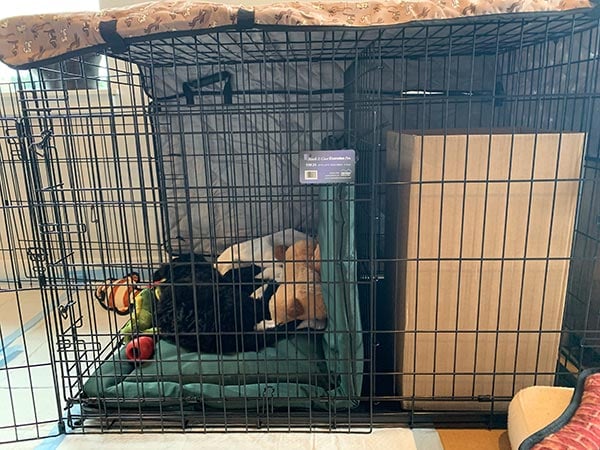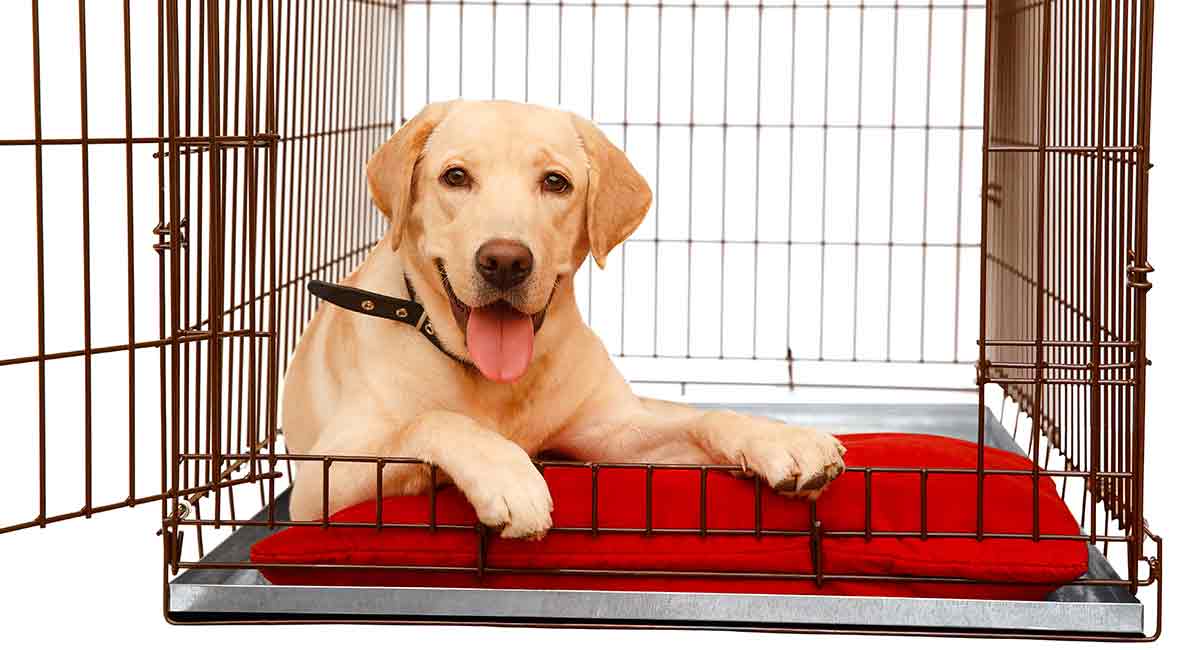For a Labrador puppy, a crate size of 30 to 36 inches is ideal. This allows enough space for growth while providing a cozy environment.
Choosing the right crate for your Labrador puppy is essential for training and comfort. A proper crate can create a safe space for your pup, aiding in housebreaking and reducing anxiety. Labradors are known for their playful nature and size, so selecting an appropriate crate size ensures they have room to move without feeling overwhelmed.
A crate that’s too large can hinder training efforts, as puppies may use one end as a bathroom. Finding the perfect balance will help foster a positive association with the crate and support your puppy’s development. Understanding your puppy’s needs will guide you in making the best choice.
Choosing The Right Crate Size
Finding the perfect crate size for your Labrador puppy is essential. A proper crate ensures comfort and safety. It also aids in training and helps manage your puppy’s behavior.
Factors To Consider
Several factors influence the right crate size:
- Puppy Age: Younger puppies need smaller spaces.
- Puppy Size: Labradors grow quickly; size varies.
- Purpose: Use for training, travel, or as a den.
- Comfort: The crate must feel cozy and secure.
Growth Patterns Of Labrador Puppies
Labrador puppies grow rapidly in their first year. This growth affects crate size:
| Age | Approximate Weight | Recommended Crate Size |
|---|---|---|
| 8 Weeks | 10-15 lbs | 24 inches |
| 4 Months | 25-30 lbs | 30 inches |
| 6 Months | 40-50 lbs | 36 inches |
| 1 Year | 55-80 lbs | 42 inches |
Choose a crate that allows your puppy to stand, turn, and lie down comfortably. Adjust as your puppy grows to avoid discomfort.

Credit: ottertailkennels.com
Types Of Crates Suitable For Labrador Puppies
Choosing the right crate for your Labrador puppy is essential. Different types of crates serve various needs. Here are the most suitable options:
Wire Crates
Wire crates are popular for many reasons:
- Visibility: Puppies can see their surroundings.
- Ventilation: Good airflow keeps your puppy comfortable.
- Durability: Strong materials resist chewing.
Look for these features:
- Divider panel for growth.
- Easy to clean removable tray.
- Foldable design for storage.
Plastic Crates
Plastic crates offer a cozy den-like space. They have unique benefits:
- Privacy: Puppies feel secure in enclosed spaces.
- Lightweight: Easy to transport.
- Weatherproof: Suitable for outdoor use.
Check for:
- Proper ventilation holes.
- Sturdy latches for security.
- Size options for growing puppies.
Soft-sided Crates
Soft-sided crates are great for travel. They are flexible and lightweight:
- Easy to set up: Quick to assemble and disassemble.
- Comfortable: Often padded for extra coziness.
- Portable: Ideal for car trips and camping.
Important features include:
- Mesh panels for ventilation.
- Water-resistant material.
- Secure zippers to prevent escapes.
Benefits Of Crate Training
Crate training offers many benefits for your Labrador puppy. It creates a safe space for your pet and helps with their training. Understanding these benefits can make crate training easier.
Safety And Security
A crate provides a safe environment for your puppy. Here are some key points:
- Prevents accidents in the house.
- Protects from dangerous items.
- Offers a cozy space for rest.
Your puppy will feel secure in their crate. It becomes a personal den where they can relax.
Aid In House Training
Crate training helps with house training your puppy. Here are some benefits:
- Encourages your puppy to hold their bladder.
- Establishes a routine for bathroom breaks.
- Helps you monitor their needs.
Using a crate makes it easier to teach your puppy where to go. Consistency is key for successful house training.
Reducing Anxiety
A crate can help in reducing anxiety for your Labrador puppy. Here’s how:
- Offers a safe retreat during loud noises.
- Helps with separation anxiety.
- Creates a familiar space while traveling.
By using a crate, your puppy learns to feel calm and secure. This reduces stress for both you and your pet.

Credit: www.mac-alum.com
Setting Up Your Puppy’s Crate
Creating a comfortable and inviting space for your Labrador puppy is essential. A well-set-up crate helps your puppy feel safe and secure. Follow these tips to make the crate a cozy haven.
Comfortable Bedding
Choose the right bedding for your puppy’s crate. Soft and plush bedding provides comfort. Here are some options:
- Memory foam mats
- Cozy blankets
- Washable dog beds
Ensure the bedding is easy to clean. Puppies can have accidents. Replace wet bedding quickly to maintain a hygienic space.
Location And Accessibility
Pick a suitable spot for the crate. Avoid noisy areas. A quiet corner helps your puppy relax. Consider these factors:
- Proximity to family activities
- Temperature control
- Avoid direct sunlight
Make the crate accessible. Use the crate for training, feeding, and sleeping. This teaches your puppy that the crate is a positive place.
Toys And Accessories
Add toys to your puppy’s crate. Chew toys and soft toys can keep your puppy entertained. Here are some recommended toys:
- Durable rubber toys
- Stuffed animals
- Interactive puzzle toys
Rotate toys regularly. This keeps your puppy engaged. Avoid toys that could be harmful or small enough to swallow.
Crate Training Tips
Crate training is vital for Labrador puppies. It helps them feel secure. Here are some effective tips to make the process easier.
Positive Reinforcement
Use positive reinforcement to encourage good behavior. This method rewards your puppy for entering the crate. Here are some ways to do this:
- Give treats when your puppy enters the crate.
- Use a calm voice and praise them.
- Play with toys inside the crate to create a fun space.
Repeat this daily. Your puppy will associate the crate with positive feelings.
Gradual Introduction
Introduce the crate gradually. Start with short periods. Here’s a step-by-step plan:
- Let the puppy explore the crate without forcing them.
- Feed them meals inside the crate.
- Close the door for a few minutes while they eat.
- Slowly increase the time they spend inside.
This gradual approach helps them adjust comfortably.
Dealing With Whining Or Barking
Whining or barking can be common. It’s important to handle this calmly:
- Avoid letting them out while they are noisy.
- Wait for silence before opening the crate.
- Check for needs like bathroom breaks or hunger.
Consistency is key. Over time, your puppy will learn to relax in the crate.

Credit: www.argylejewelers.com
Conclusion
Choosing the right crate size for your Labrador puppy is essential for their comfort and safety. A properly sized crate helps with training and creates a secure space for your pet. Always consider their growth. Investing in the right crate now will pay off in a happier, well-adjusted companion later.
